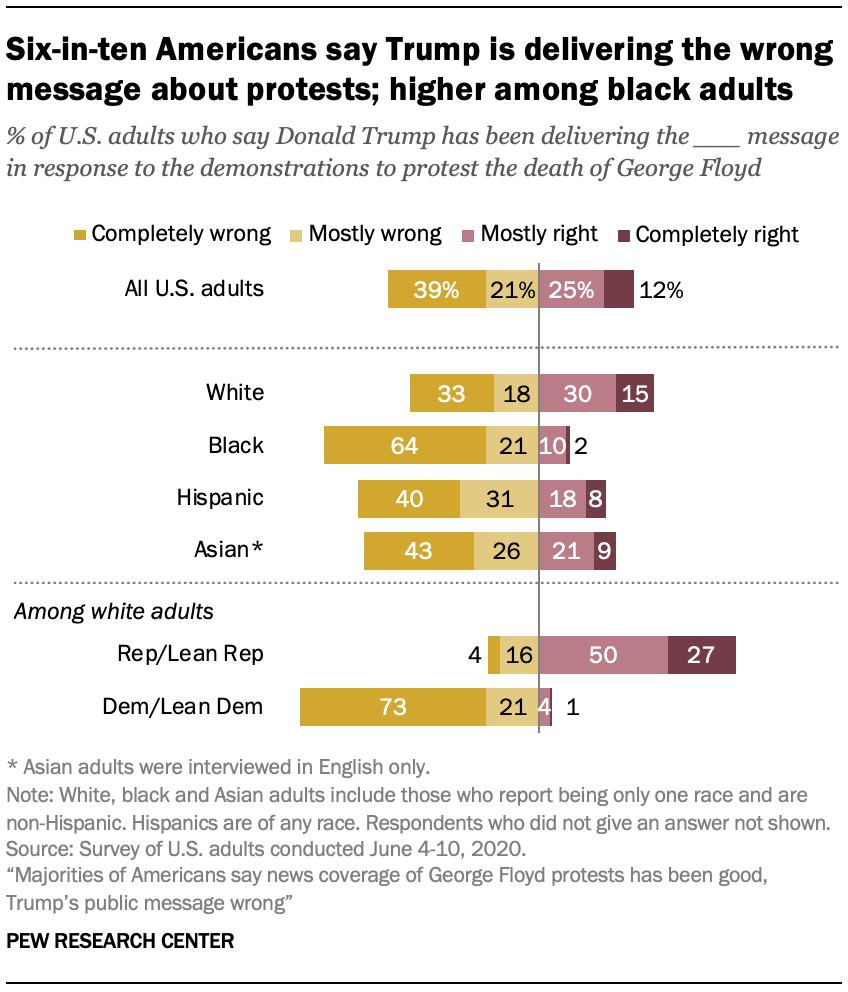
Amid close attention to the news surrounding the death of George Floyd and ensuing protests, a majority of the public says Donald Trump’s messaging about the demonstrations has been wrong, while a similar portion says the news media’s coverage of the protests has been good.
Six-in-ten Americans say Trump has been delivering the wrong message to the country in response to the protests, including about four-in-ten (39%) who say his messaging has been “completely” wrong and 21% who say it has been “mostly” wrong. Fewer (37%) say his message has been right, including just 12% who say it has been “completely” right.
Overall, 85% of black Americans say Trump has delivered the wrong message, including nearly two-thirds (64%) who say his message has been completely wrong. Just 13% of black Americans say Trump has delivered the right message (with a mere 2% who say his message has been completely right). Hispanic and Asian Americans give almost as negative an assessment, with about seven-in-ten or more in each group saying Trump has been delivering the wrong message.
White Americans also are more likely than not to say Trump’s message has been wrong, though by a much smaller margin. About half of white Americans (52%) say his message about the protests has been mostly or completely wrong, compared with 45% who say the message has been right.
Among white adults, there is a stark divide by party. Fully 94% of white Democrats (including self-described independents who lean Democratic) say Trump has been delivering the wrong message about the protests, while 76% of white Republicans say Trump has delivered the right message. Still, white Democrats are more than twice as likely to say Trump’s message has been completely wrong (73%) than white Republicans are to say the president has been completely right (27%).
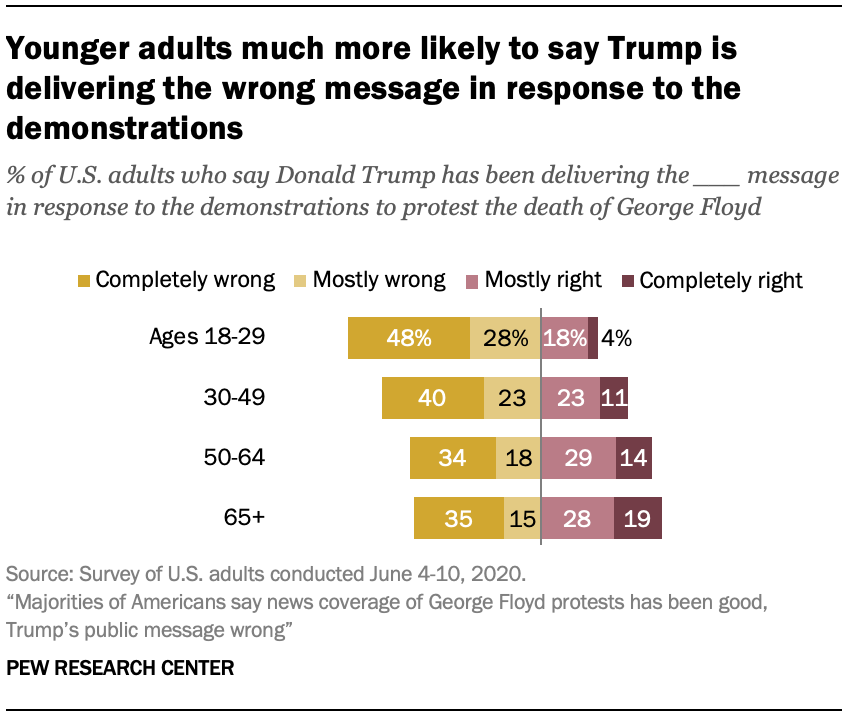
The youngest U.S. adults, those ages 18 to 29, have the harshest assessment of the message Trump has been delivering about the protests. About three-quarters (76%) of those ages 18 to 29 say his message has been wrong, including close to half (48%) who say it has been completely wrong. Just 22% say it has been right.
Americans ages 65 and older, meanwhile, are evenly divided between those who say Trump’s message has been wrong (49%) and those who say it has been right (47%).
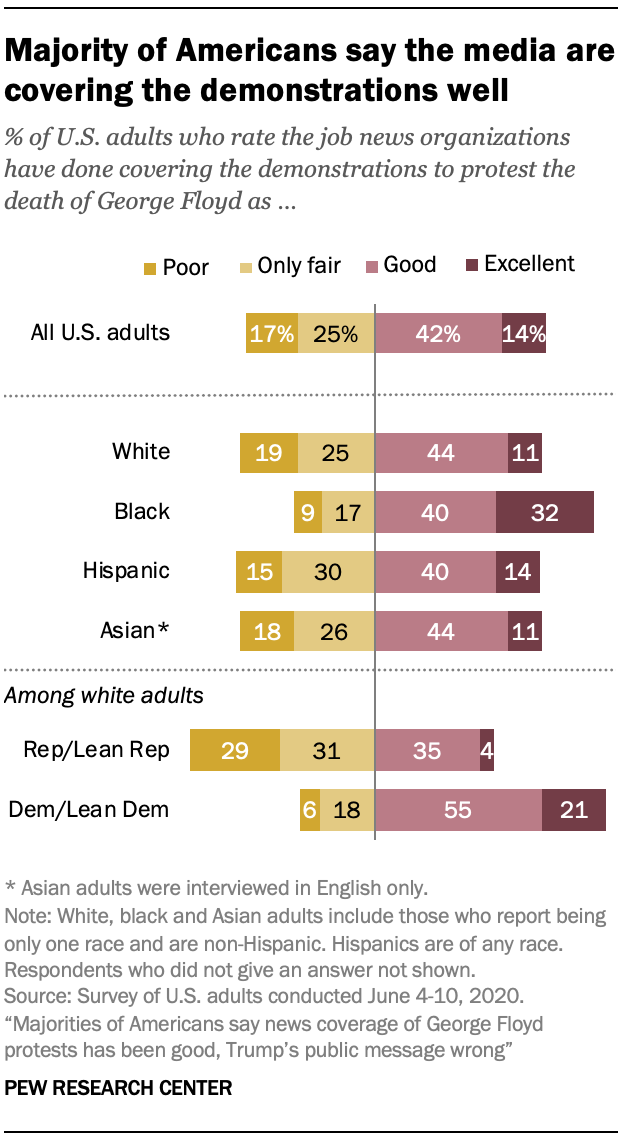
The public’s negative view of Trump’s public statements stands in contrast to its more positive assessment of media coverage of the recent protests. Overall, 57% of U.S. adults say the news media have done an “excellent” (14%) or “good” (42%) job of covering the demonstrations to protest the death of George Floyd. About four-in-ten say the media have done an “only fair” (25%) or “poor” (17%) job.
Black Americans give a particularly strong assessment of news coverage, which is in stark contrast to their rejection of Trump’s message. Fully 72% of black adults say the news media have done at least a good job, including about a third (32%) who say they have done an excellent job. By contrast, in a telephone survey conducted in 2015 about the demonstrations to protest the death of Freddie Gray, a black man who died in police custody in Baltimore, just 11% of black adults said the news media had done an excellent job covering the story; another 35% said at the time it had done a good job. (Overall, the public generally gave the news media less positive ratings in 2015.)
White Americans also give more positive than negative assessments of news coverage, with 55% saying the news media have done a good or excellent job and 44% rating their performance as fair or poor. But as seen in the assessment of Trump’s public messaging on the issue, strong party divides exist among white Americans. While 76% of white Democrats say the news media have been doing well covering the protests, about half as many white Republicans say the same (39%). Instead, a majority of white Republicans say the media have been doing a fair (31%) or poor (29%) job.
Hispanic and Asian Americans fall a little closer to white Americans in their assessment of media coverage, with small majorities saying the news media are doing at least a good job covering the protests.
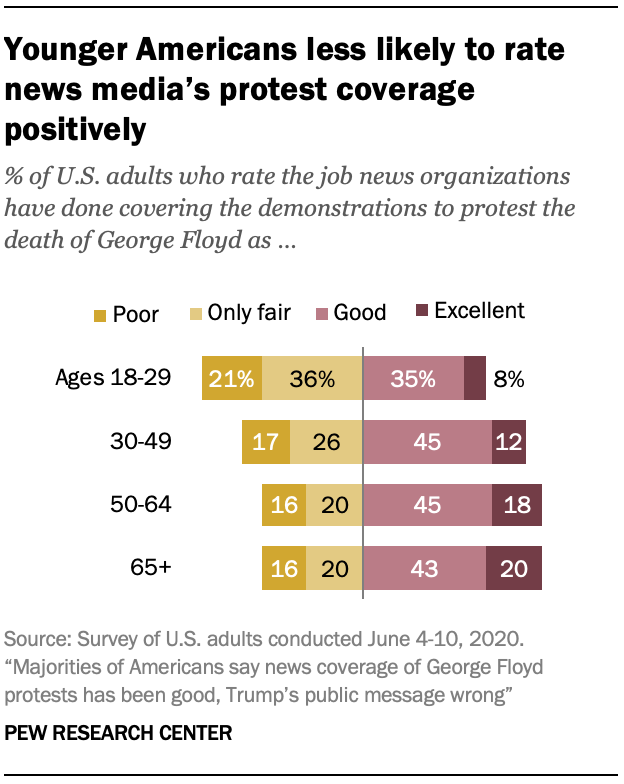
Young adults exhibit a more critical eye toward news coverage of the protests than their elders – although they are not as negative toward the news media as they are toward Trump. Still, a majority of 18- to 29-year-olds (56%) say the media coverage of the protests has been only fair or poor, compared with 43% who say it has been good or excellent. Among all other age groups, majorities give a positive rather than negative assessment.
Half of Americans say demonstrations have gotten the right amount of attention; about four-in-ten say there is too much focus on the protests
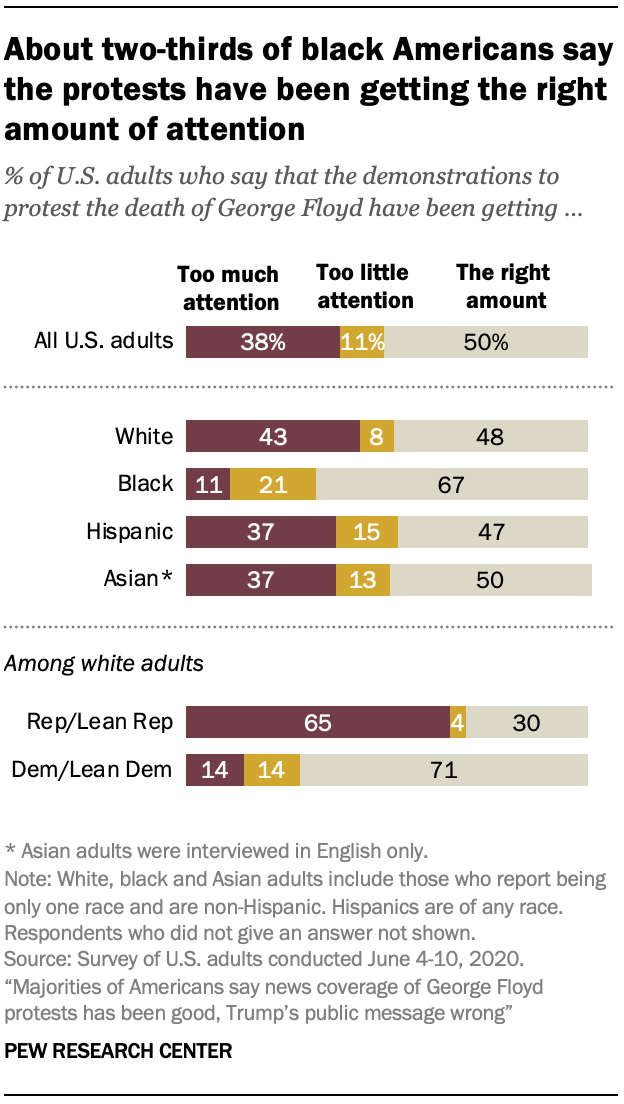
All in all, half of Americans say the demonstrations protesting the death of George Floyd have been getting the right amount of attention. The remainder is much more likely to say the demonstrations have gotten too much attention (38%) as opposed to too little (11%).
Black Americans are more likely to approve of the level of attention given to Floyd’s death and the following protests, with 67% saying the demonstrations have gotten the right amount of attention. In contrast with the general public, black adults are more likely to say the protests have gotten too little attention (21%) rather than too much (11%). White adults, meanwhile, are five times as likely to say the protests have gotten too much attention (43%) as they are to say too little (8%).
Again, there is a strong partisan divide among whites. About seven-in-ten white Democrats (71%) say the demonstrations have gotten the right amount of attention, while a similarly large share of white Republicans (65%) say they have gotten too much attention.
Older Americans also are more likely than young adults to say too much attention has been paid to the protests.
The survey also asked a series of questions about whether news organizations specifically are giving too much coverage, not enough coverage or about the right amount of coverage to several aspects of the broader story surrounding Floyd’s death.
Acts of violence and destruction that have occurred around the protests are the only storyline of the six that a plurality of Americans say is receiving too much coverage. More than four-in-ten U.S. adults (44%) say this element of the story is getting too much coverage, compared with about half as many (20%) who say coverage is too light and 36% who say the level of coverage has been about right.
Conversely, about half of U.S. adults (51%) say nonviolent protests are getting too little coverage, with another 36% saying they are getting the right amount of coverage and far fewer (12%) saying there has been too much.
During the time the survey was conducted (June 4-10), roughly half of Americans said the level of coverage was appropriate on three topics: the decision of whether to prosecute the officers involved in George Floyd’s death (53%), circumstances surrounding the death of Floyd himself (47%) and the actions taken by police in response to the protests (46%). In each case, more Americans say these stories have been getting too little coverage rather than too much.
U.S. adults are less likely to say larger issues of race relations are getting about the right amount of coverage (34%). But there is no strong consensus on what the media should be doing: 38% say there has not been enough coverage given to race relations more broadly, while 27% say there has been too much coverage.
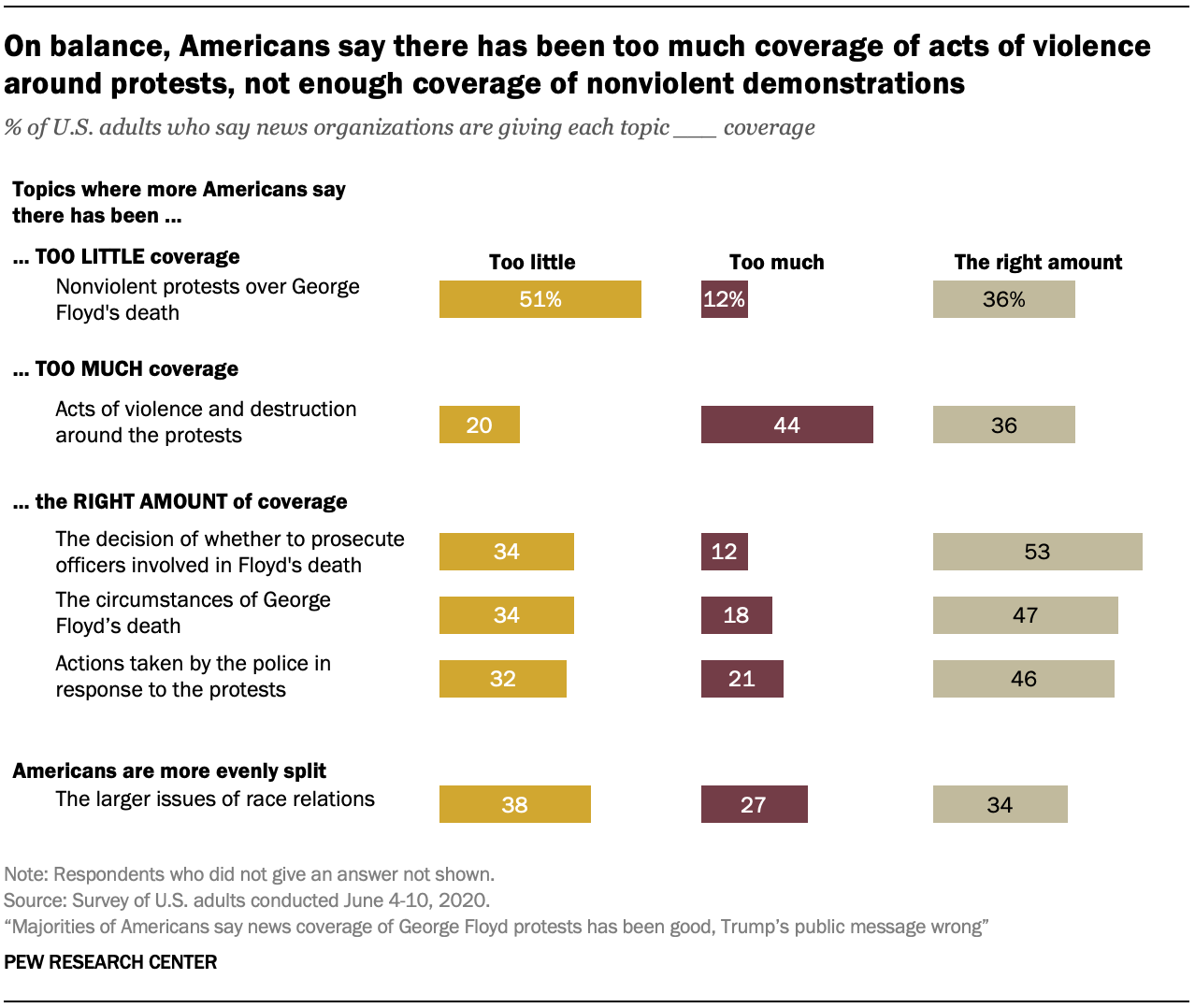
Black Americans say decision about prosecuting Minneapolis officers and larger issue of race relations should get more coverage
Black and white Americans express some general agreement in the level of attention the news media have been giving to some elements of the story. But black Americans are more likely than white Americans to say too little coverage is being given to the decision of whether to prosecute the officers involved in George Floyd’s death and to the issue of race relations more broadly. White adults, on the other hand, are more likely to say too much coverage is going to the acts of violence and destruction during protests.
The two storylines where black and white Americans express the most similar sense of coverage are the death of Floyd itself and police actions in response to protests. Close to half of both groups say the amount of coverage in these areas has been about right. And among those who say it hasn’t been right, larger portions of each group say there has been too little coverage as opposed to too much.
Similarly, about half of both black (48%) and white (51%) Americans say the news media have produced too little coverage of nonviolent protests. Black adults are somewhat more likely than white adults to say the level of coverage has been about right (44% vs. 35%), but only small minorities of each group say there has been too much coverage.
The two angles where black and white adults diverge the most are the decision of whether to prosecute the officers involved in Floyd’s death and the larger issue of race relations. Half or more of black Americans say the news media are giving too little coverage to each of these issues, with most of the remainder saying the level of coverage has been about right and very few saying there has been too much coverage. On the other hand, only 28% of white Americans say there has been too little coverage of whether to prosecute the officers; a majority of whites (57%) say the level of coverage has been about right. When it comes to coverage of race relations more broadly, white Americans are about equally likely to say the media’s level of coverage has been about right (34%), too great (33%) or too small (33%).
Black and white Americans also express somewhat different views about the level of attention given to the violent aspects of the protests. In this case, white Americans are more likely than black Americans to say there has been too much coverage of violence surrounding the protests (45% vs. 36%). Still, both black and white adults are more likely to say there has been too much coverage of this, rather than too little.
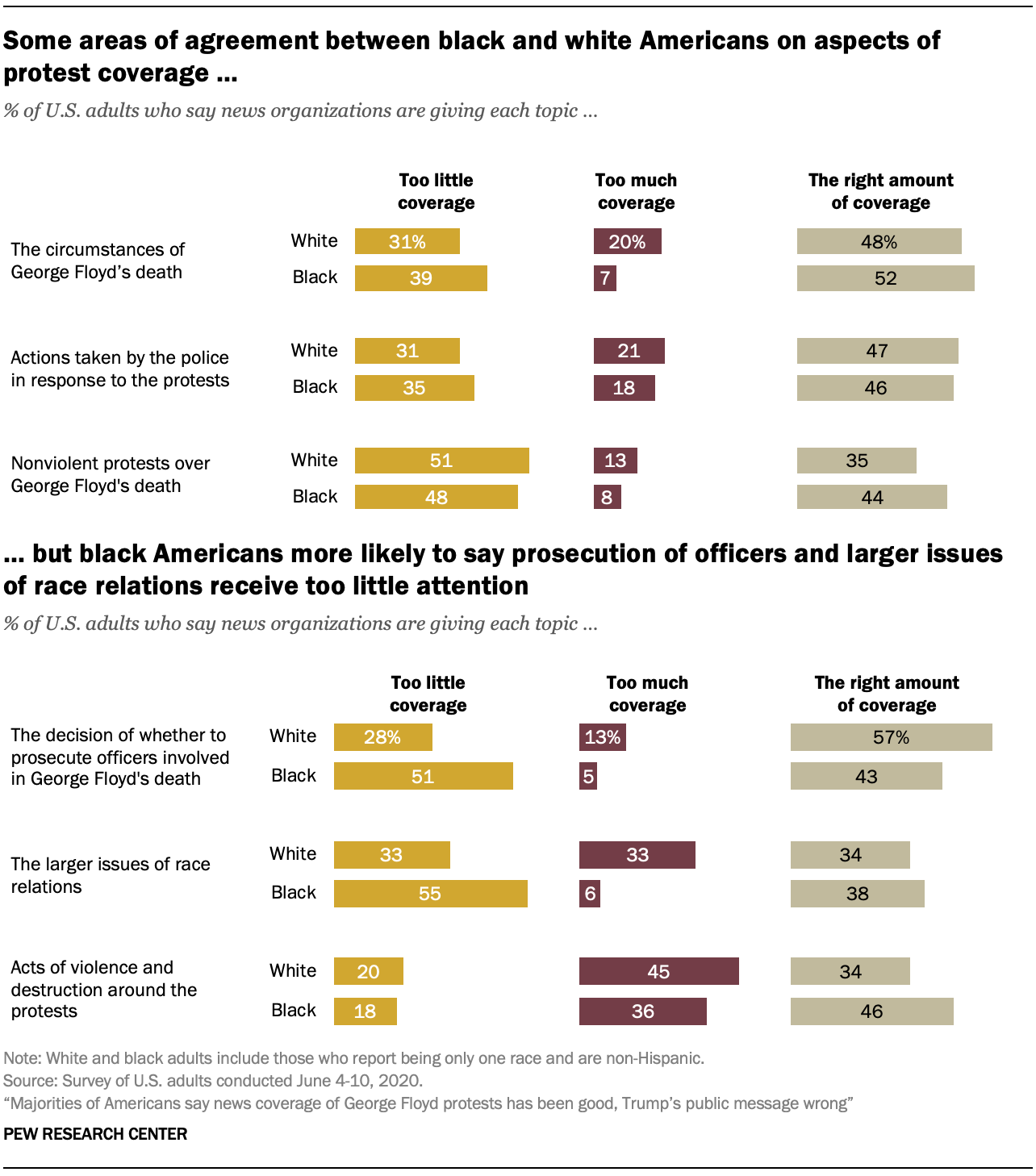
Here again, some partisan differences emerge among white adults. The angle where views vary the most is in coverage of the larger issues of race relations: Fully half of white Republicans say there has been too much coverage of the larger issues of race relations, while only 9% of white Democrats agree. Instead, roughly half of white Democrats (51%) say there has been too little coverage of race relations more broadly (compared with 19% of white Republicans who feel this way).
Differences also arise in the level of coverage given to the circumstances surrounding George Floyd’s death. A solid majority of white Democrats (61%) feel the level of coverage has been right, followed by 30% who say there has been too little coverage and just 9% who say there has been too much. White Republicans, meanwhile, are much less likely than white Democrats to say the level of coverage of Floyd’s death has been about right (39%) and much more likely to say there has been too much coverage (28%).
White Republicans are more likely than white Democrats to say that there has been too little coverage of violence surrounding the protests (28% vs. 10%), while white Democrats are more likely to say the coverage of this has been about right (46% vs. 25%). Still, a plurality of white Republicans (47%) say there has been too much coverage of violent acts.
White Democrats and white Republicans largely agree that there has been too little media coverage of the nonviolent protests and about the right amount of coverage about the decision of whether to prosecute the police officers involved in Floyd’s death.
Partisan differences across all U.S. adults are discussed in Chapter 3.
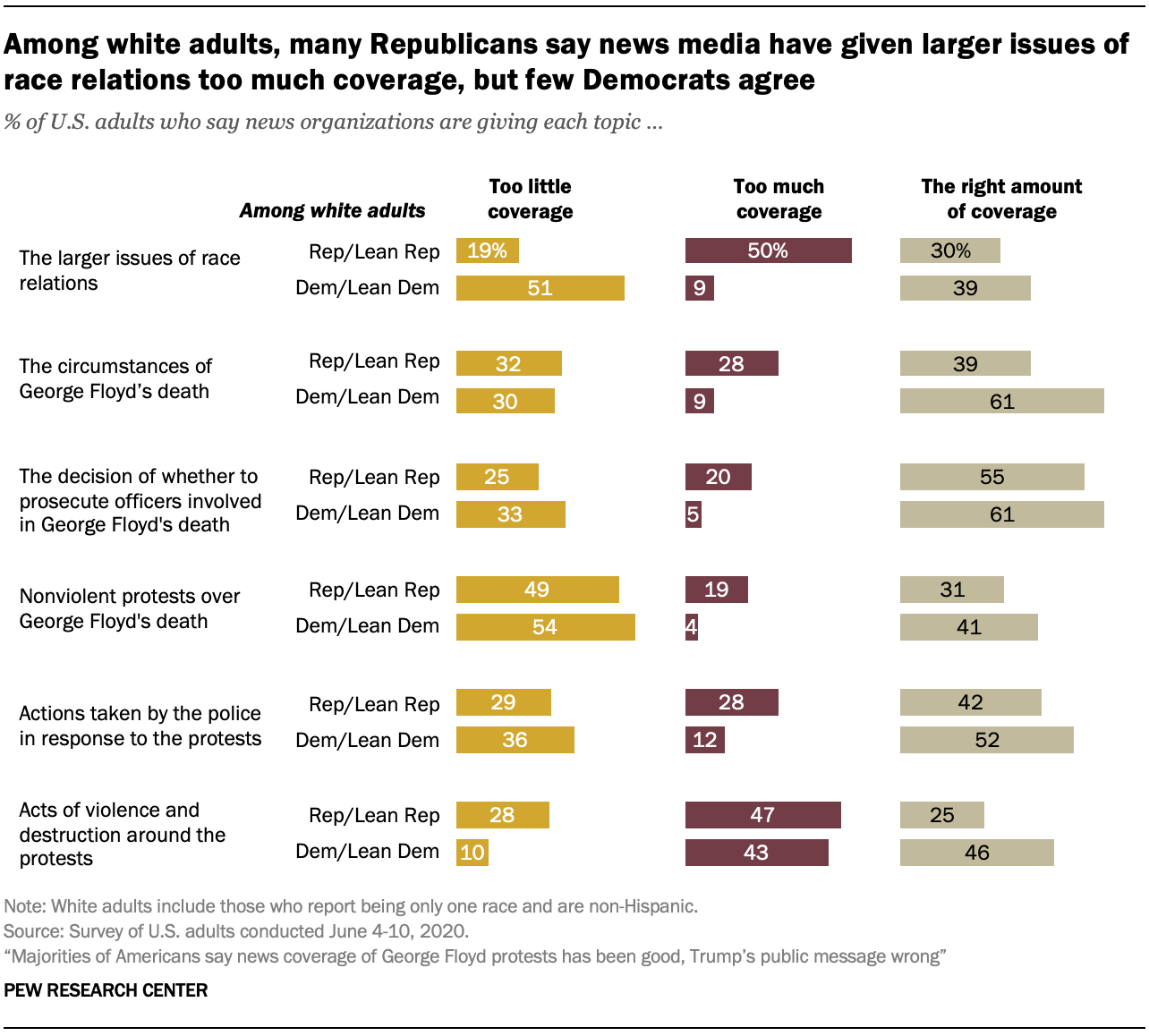
Young adults most likely to say there has been too little coverage of nearly all storylines
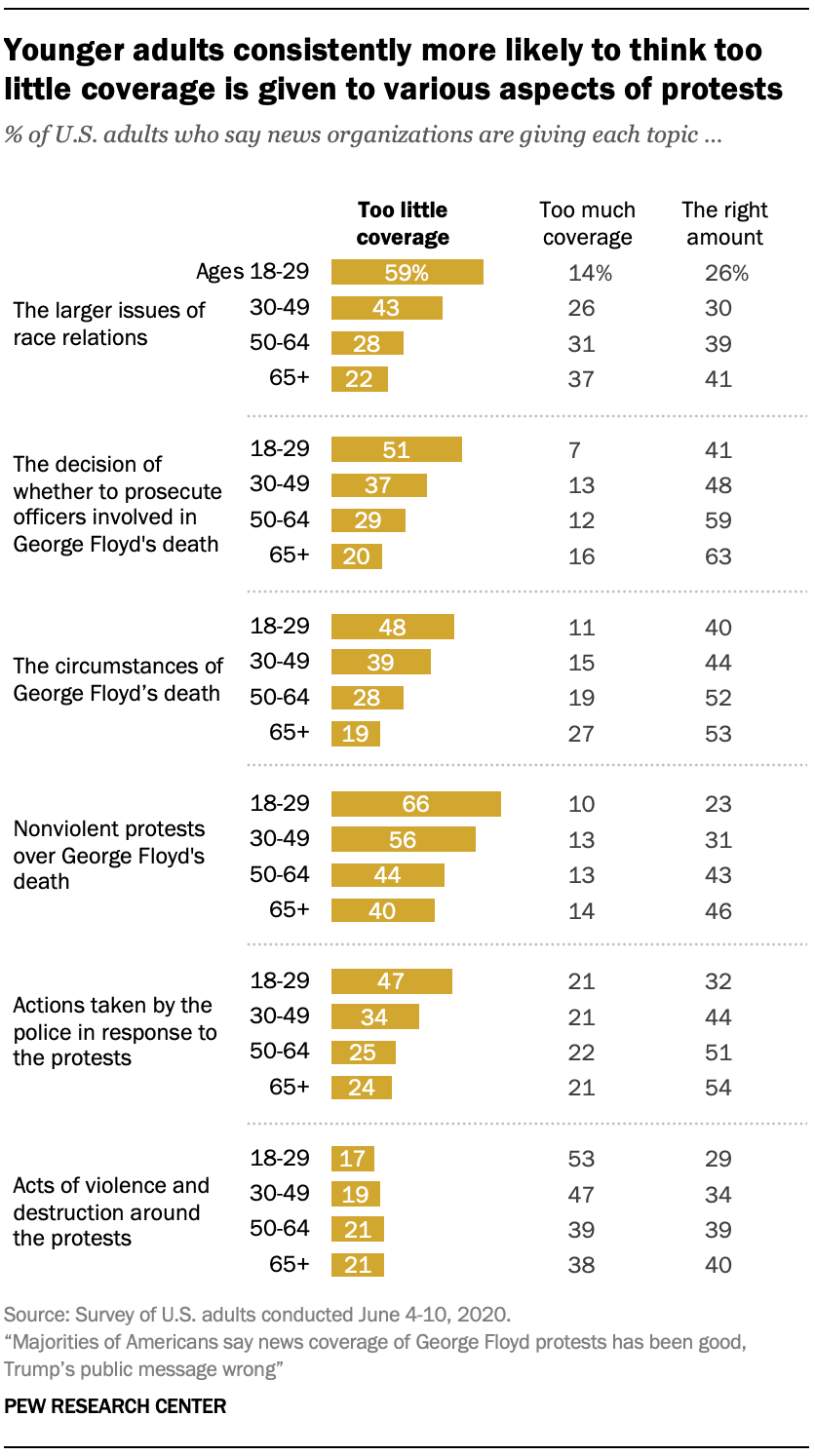
Some of the most consistent disagreement on the level of attention the news media have been giving different elements of the events around Floyd’s death is between younger and older Americans.
On five of the six topics asked about in the survey, U.S. adults under 30 are more likely than all other age groups to say that they received too little coverage. There are particularly large divides between the oldest and youngest Americans: those 18 to 29 are more than twice as likely as those 65 and older to say there has been too little coverage of the larger issue of race relations (59% vs. 22%), the decision of whether to prosecute the officers involved in Floyd’s death (51% vs. 20%) and the circumstances surrounding Floyd’s death (48% vs. 19%).
About two-thirds (66%) of the youngest adults, along with 56% of those ages 30 to 49, say there has been too little coverage of the nonviolent protests, compared with fewer than half of those ages 50 to 64 (44%) and 65 and older (40%). Additionally, 47% of those ages 18 to 29 say that the news media are giving too little coverage to actions by the police and National Guard in response to the protests, higher than any of the older age groups.
The only topic that does not follow this pattern is coverage of acts of violence and destruction around the protests. Younger adults are slightly more likely than their elders to say that there has been too much coverage of violence and destruction.




